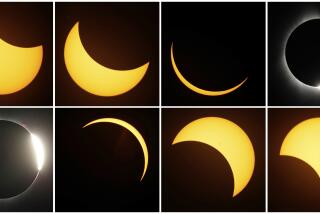At the winter solstice, an appreciation for the wonders of a night sky
Saturday is the winter solstice, the shortest day of the year in terms of daylight hours -- and perhaps a sun lover’s nightmare and a stargazer’s delight.
Jack Fusco falls into the second category, and his time-lapse video above shows how fascinating the heavens can be. The more than 2,000 photos he took during the October Jasper Dark Sky Festival in Alberta, Canada, create an ethereal portrait of an area that ranks low in light pollution.
That’s distinctly different from New Jersey, where he began to experiment with photography by taking photos of the ocean at sunrise. When he shot pictures at sunset and saw stars, though, his photography took another turn.
“I started staying out later and later and experimenting more,” he said. “When I started I didn’t know anything about astronomy.”
Now he’s ventured in to the field of landscape astrophotography, described on the Landscape Astrophotography website “as the discipline of blending Earth elements with those of the night sky in compelling photographic imagery.”
Here’s how Jasper entered the picture: “Jasper was always a place I wanted to visit since I saw my first photo [of it],” Fusco said. “The first time I saw Moraine Lake, it was amazing -- blue lakes, gorgeous mountains in the background.” Photographing it seemed “kind of like cheating because it’s just so beautiful.”
Fusco’s time-lapse video called Home at the Shore caught the attention of National Geographic. That caught the eye of Travel Alberta. Within weeks Fusco was packing his bags for the western Canadian province for the dark sky festival in Jasper, whose website claims it is “home to the world’s largest Dark Sky Preserve,” a place so free of light pollution that it makes for extraordinary stargazing.
Those interested in the heavens might find help from a couple of apps Fusco said he likes: an Android app called Mobile Observatory and an iPhone app called Star Walk.
Fusco said that because of his passion for learning, he slept little during the festival because he wanted to hear talks and lectures presented during the day. (“David Levy was there!” he said of the man called the Comet Hunter.) At night and into the wee hours, Fusco was shooting the photos that fill his time-lapse creation.
Because such photography requires long exposures -- 20 to 30 seconds -- he used most of the shots in his video. It takes about 12 minutes of exposures, he said, to make one second of video.
It was brisk -- about 20 degrees -- but he said he didn’t mind: “It was one of those feelings where you sort of lose yourself.”
And gain a work of art.
More to Read
Sign up for The Wild
We’ll help you find the best places to hike, bike and run, as well as the perfect silent spots for meditation and yoga.
You may occasionally receive promotional content from the Los Angeles Times.






